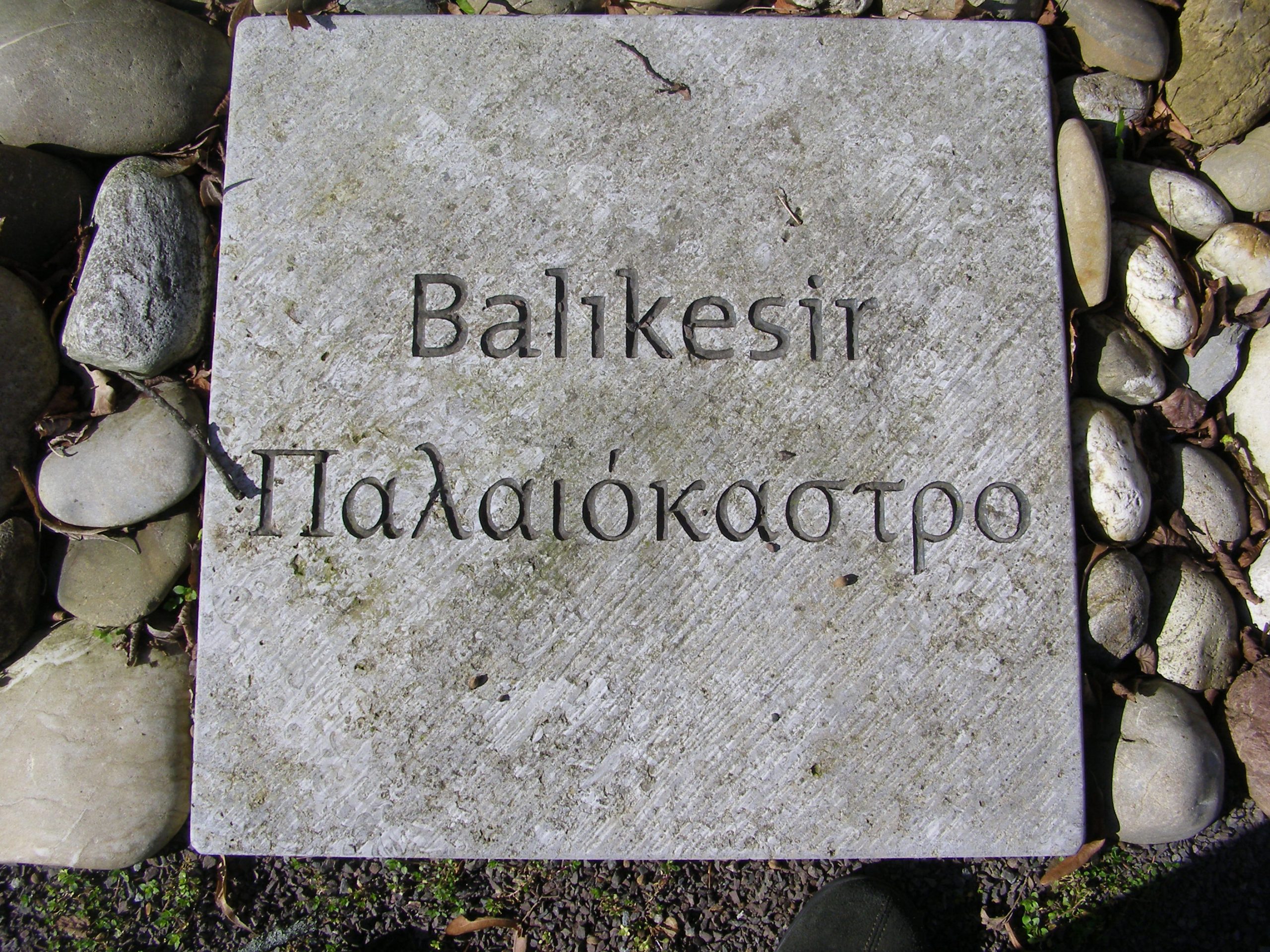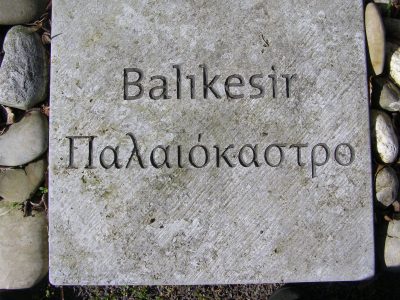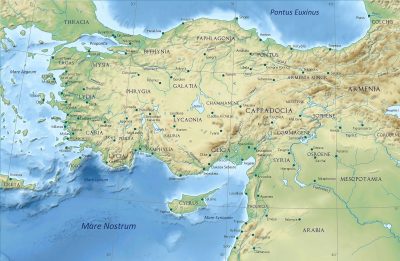
In ancient times, the later Ottoman sancak of Karesı (Karası; Karasu) was part of the region Mysia, whose north was also known as Little Phrygia (Mikra Phrygia). In the northeast, Mysia bordered Bithynia, in the west the Troad region and in the southeast Phrygia. One of the two Mysian urban centers, Kyzikos (Gr: Κύζικος, today: Balız, near Erdek) on the Propontis, was situated in the later Ottoman sancak Karesı. The direct predecessor of the Karesı sancak was the Beylik (Beyliği) Karası, which the neighbouring Ottomans conquered in 1361 as the first Turkic Beylik.
The name of the sancak’s administrative center Balıkesir (until 1926 Karesı, Gr: Μπαλικεσίρ Mpalikesír) is derived from the Greek Παλαιοκάστρον (Palaiokastron, ‘Old castle’). The area is famous for vegetable and fruit growing, and there are several well-known thermal baths in the surrounding area. In the vicinity of Balıkesir are the ancient cities of Argyria (Agissa, Argiza), Skeptic and Ergasteria and Mount Ida, from which Zeus is said to have observed the battles for Troy.
Population
The sancak Karası comprised the Greek Orthodox diocese of Kyzikos with a population of ‘41,331 souls’ in 43 communities.(1) According to the 1913-4 census of the Armenian Apostolic Patriarchate of Constantinople, there were approximately 20,000 Armenians in the sancak of Karesı (Karası), “almost all of whom were concentrated in the kazas of Bandırma and Balıkesir. The colonies of this sancak, which had close ties to Istanbul and Bursa by virtue of their geographic location, had been founded in the first years of the seventeenth century.”[2]
Boycotts, Persecution and Deportations in the Sancak Karası
The Greek Orthodox Christians (‘rumlar’) were the first victims of discriminative boycotts, persecutions and deportations before and during WW1.
“(…) Turkish bands engaged for the purpose visited the villages and prevented the customers from entering Greek shops, while preachers from the top of the minarets incited the Turks to take even severer steps for making the boycott more efficacious. The communities of Balikesser [Balıkesir], Sikaminea, Geltze, Diavati, Upper and Lower Neohori, and Smavlo, suffered from the boycott as well as from plundering and persecutions carried on in the very presence of Government officials. Artaki [Erdek; kaza Bandırma], Sidirye, Panderma [Tr: Bandırma], and Balia(3) faced none the better.
It is a remarkable fact that, despite the promises made by the Minister of the Interior, Talaat Bey, to the Christian population of Panderma that he would stop the boycott, it was applied with even greater severity each time, proving the dublicity of the Turks in their dealings with the Christian populations.
- Deportations in 1914
The deportation of the Christian populations began by the independent Sandjak of Karassi, notwithstanding their protests, and included the purely Christian villages of Tach-Kisse, Koupassi, Hadji-Boghon, Mandiri, Yeni-keuy [Tr: Yeniköy], Kodja-Bounar, Aladja-Bair, Teipelen, Souyout [Söğüt], Alaklissa [Alakilise; today Gündoğdu], Karaidin, and Ivrindi. This was in April 1914. A number of the Christians were conducted to Balia and the Interior of Asia Minor; the others crossed over to the European coast. No sooner were these villages evacuated than they were occupied by Pomak Moslems.
All the Greek subjects of Bali, including those belonging to the new provinces annexed to Greece, were deported, to be followed by the Christian Ottoman subjects in whose houses the government had established Turkish immigrants, under the pretext of forming a national guard, but obviously with the object of intimidating the Christians.
On the 5th July, 1914, Constantinos Paraskevas, a native of Eskikeuy [Eskiköy] (Diocese of Kolonia), was found strangled in his small house, close to the village of Al-Tsali, at a distance of one hour and a half from Balia, where he had established himself some year ago. The Turks of the above village had warned him about a month before that unless he quitted the Ottoman territory he would be molested, and about a fortnight before this his house had been broken into and pillaged. On the 15th of the same month Demitri Spanos was found murdered in his mill, in the Turkish village of Kodja-Avsar; a certain Stavros Georgiou, a native of Ivrindi, was killed. These two men were in the employ of the Balia Mining Society. On the 22nd May, 1914, two rascally Turks of the village of Poussoumler went to the sheepfold of Nicolas Kelebeli, at Sindiriyi, and asked his son for bread and food, and on obtaining what they wanted they attacked him with their stick and knives, saying: ‘You may well write to your Patriarchate, you infidels, we shall annihilate you.’ Finally, they bound their victim, and left, carrying away with them eighty-five sheep. Such an attempt at murder greatly alarmed the community at Sindiryi, and their fear increased still further by the Turkish students from Balikesser [Balıkesir], at the beginning of July, 1914, marching through the streets singing a song of hatred and revenge against the Greeks.
On the 2nd August, 1914, a boy of fifteen years old, named Christos Vassiliou Sariyannis, was found slaughtered at Mylos, a country place, ten minutes distant from Artaki [Erdek]. The authorities to whom the perpetrator of this crime was known, instead of arresting him, put the victim’s father into prison, and kept him there for months as having been the cause of his son’s death. Towards the end of September, a young Turk, twenty years old, beat the priest Loukas of the village of Edindjik, an old man of eighty-five, and broke is arm and leg. He was taken to the Greek hospital, where he died of his wounds. On the 20th October, Panayiotis Georghiou and his son George were found atrociously slaughtered in the mill, half an hour distant from Artaki.
On the 8th December, Turks disguised as soldiers, attacked a mill close to Artaki, beat the miller, Paul A. Konnou and his host, and retired carrying away all the flour they found in it.
2. Deportations in 1915
The accusation that they supplied enemy submarines was falsely brought against the inhabitants of this district during the European War. The evacuation of certain communities was ordered and their inhabitants sent to the interior of Asia Minor.
- BALAT [Gr: Paláti – ‘Palace’; ancient Gr: Hadrianeia; today Dursunbey], and 2. KEPSIT. – These villages were evacuated in May, 1915. The Turks attacked the Church of Kepsit, desecrated the sacred vessels, tore up the vestments and church books, and broke open the safe.
- MOUSATZA, 4. HAVOUTSI. – On the 2nd June, 1915, more than 500 Turks entered the village of Havoutsi, committing all kinds of atrocities and threatened the life of Pope Constantinos. He escaped murder by paying a ransom. The inhabitants of the two villages were expelled and sent to Guionen.
- KOURSOULI. – Armed bands of savage Turks attacked the village, and burnt two persons alive after having dipped them into petroleum. The dead bodies of the two victims were photographed by the International Commission, sent there for purposes of investigation. In July, 1915, the inhabitants were deported to Mihalitsi [Tr: Mihaliç].”
Source: Ecumenical Patriarchate: Persecution of the Greeks in Turkey, 1914-1918. Constantinople (London: Hesperia Press, 1919), p. 56-58
In April 1916, the Christian refugees of the villages in the vicinity of Balıkesir underwent persecution from the Turks. They were refused bread on payment. The women were told that they should become Muslim so as not to die of hunger. In the beginning of June, 1916, many young Greek girls were forced by the authorities to convert to Islam at Government headquarters.[4]
The deportations of the sancak’s Armenian population were organized in August 1915, under the direction of Ahmet Midhat Bey, the mutesarrıf of Balıkesir, and others.[5]
Deportation of Armenian workforce from Intelli: Testimonial of Levon Khachaturian, Aleppo, 9 July 1916
“I have been working as a railway worker for Engineer Koeppel in Enteli [Intilli] for 6 months. On 16 June, while we were working, we were suddenly led away by gendarmes, without any consideration for the sick, children and old people, and with no possibility of taking our possessions with us. We were driven with blows from the butts of guns as far as Bulanek-Baghché, which was already full of workers from Keller, Yarbashi, Airan and other towns. You could have believed that the Day of Judgement had dawned. You only had to look at the women and children to get an impression of what was happening. After three days, the government wrote down the names of all the workers who had no families and, without giving us any bread or the opportunity of buying something for ourselves, we were driven forwards with blows from the butts of guns to Tshakiroglu [Çakıroğlu], Fundadjak [Fundacak], Marash, Karaküjükli [Karayüklı], Aintab, Nisib, Biredjik [Birecik], Urfa, Karasu: in other words, probably a distance of 200 km, with old and sick people and children among us. About 70 men were killed by rifle shots in the area around Marash, namely near Fundadjak. We had to buy water near Marash that not even animals would have accepted. The gendarmes sold us a glass of tea made of this water for one piastre. There were 250 to 300 people from Marash among us. Their relatives came, but were not allowed to speak to them. They brought bread, but were not allowed to distribute it. We were driven to Karaküjükli with blows from the butts of guns and sticks, where we were given two loaves of bread, i.e. which we were allowed to buy for three metallics. There was nothing to eat until Biredjik; in Biredjik each of us received bread for 6 metallics. When we left Urfa we received nothing. There were 1,000 of us in the beginning; 623 of us were left in Urfa and Karasu. I do not know what happened later on. The Arabs assured us that the gendarmes would lead us to our death. I managed to escape here with great difficulty. I can neither speak nor write of the details. I arrived in Aleppo without a pfennig [German penny].”
[Leon Khatschadurian](6)
Source: Report from the Consul in Aleppo (Walter Rössler) to the Ambassador on Extraordinary Mission in Constantinople (Wolff-Metternich), Aleppo, 10 July 1916. Political Archives of the German Foreign Office (PA/AA), http://www.armenocide.net/armenocide/armgende.nsf/$$AllDocs/1916-07-10-DE-002

